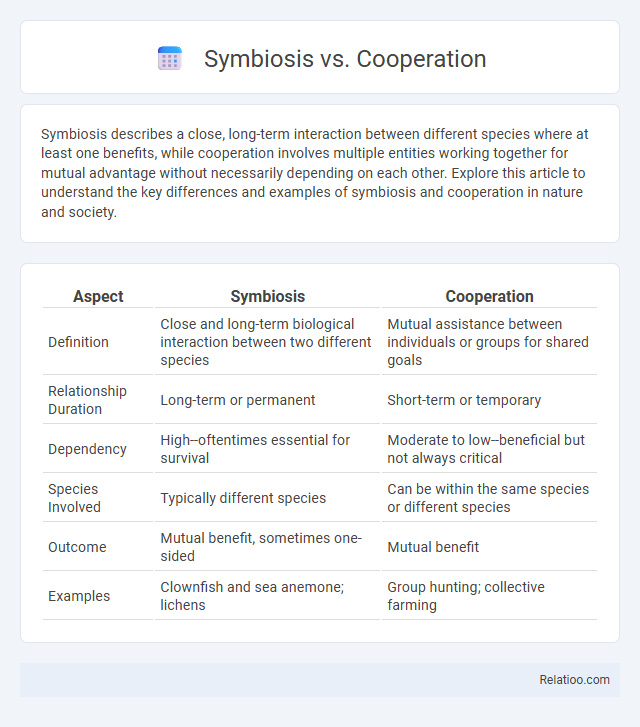Symbiosis describes a close, long-term interaction between different species where at least one benefits, while cooperation involves multiple entities working together for mutual advantage without necessarily depending on each other. Explore this article to understand the key differences and examples of symbiosis and cooperation in nature and society.
Table of Comparison
| Aspect | Symbiosis | Cooperation |
|---|---|---|
| Definition | Close and long-term biological interaction between two different species | Mutual assistance between individuals or groups for shared goals |
| Relationship Duration | Long-term or permanent | Short-term or temporary |
| Dependency | High--oftentimes essential for survival | Moderate to low--beneficial but not always critical |
| Species Involved | Typically different species | Can be within the same species or different species |
| Outcome | Mutual benefit, sometimes one-sided | Mutual benefit |
| Examples | Clownfish and sea anemone; lichens | Group hunting; collective farming |
Defining Symbiosis and Cooperation
Symbiosis refers to a close, long-term interaction between two different species that can be mutualistic, commensalistic, or parasitic, where at least one organism benefits. Cooperation involves individuals working together for mutual benefit but is not limited to species interactions and can occur within the same species. Defining symbiosis highlights its ecological complexity and enduring nature, whereas cooperation emphasizes voluntary, often short-term, mutual assistance.
Key Differences Between Symbiosis and Cooperation
Symbiosis refers to a close and long-term biological interaction between two different species, which can be mutualistic, commensalistic, or parasitic, while cooperation involves voluntary interactions where both parties benefit but may not be obligated or long-term. Key differences include the dependency level, as symbiotic relationships often imply a physical association or interdependence, whereas cooperation can occur without close proximity or lasting bonds. Furthermore, symbiosis impacts evolutionary processes more deeply since it can lead to physiological and genetic integration, unlike cooperation which is generally flexible and reversible.
Types of Symbiotic Relationships
Types of symbiotic relationships include mutualism, where both species benefit; commensalism, where one benefits without harming the other; and parasitism, in which one organism benefits at the expense of the other. Cooperation involves interactions that enhance fitness for both parties but does not necessarily involve close or long-term association like symbiosis. Symbiosis specifically refers to close and often long-term biological interactions between two different biological organisms, which may encompass cooperation as one possible mode.
Forms of Biological Cooperation
Symbiosis, cooperation, and mutualism are forms of biological cooperation that describe different interactions among species. Symbiosis refers to a close, long-term interaction between two different species, which can be mutualistic, commensalistic, or parasitic, whereas cooperation specifically involves mutual benefit without necessarily requiring close or prolonged association. Understanding these forms of biological cooperation can enhance your comprehension of ecological relationships and species survival strategies.
Mutualism: The Bridge Between Symbiosis and Cooperation
Mutualism represents a crucial link between symbiosis and cooperation by involving interaction where both species benefit and often rely on each other for survival, exemplifying symbiotic relationships like pollinators and flowering plants. Unlike general cooperation, which may be temporary or less obligatory, mutualism in symbiosis entails a close and sometimes permanent association that enhances fitness for both parties. This connection underscores how mutualistic interactions serve as evolutionary bridges fostering complex biological interdependencies and ecological balance.
Examples of Symbiosis in Nature
Symbiosis in nature includes examples like the clownfish and sea anemone, where the clownfish gets protection while the anemone benefits from food scraps. Another instance is the relationship between nitrogen-fixing bacteria and legume plants, where bacteria supply essential nitrogen, improving soil fertility. Lichens demonstrate a symbiotic union between fungi and algae, combining photosynthetic capabilities with structural support for mutual survival.
Cooperation in Animal Societies
Cooperation in animal societies involves individuals working together to achieve mutual benefits, such as shared defense, food acquisition, or care of offspring, which enhances survival and reproductive success. Unlike symbiosis, which defines long-term, close biological interactions often between different species, cooperation can occur both within and between species without requiring permanent physical association. This behavior plays a crucial role in social structures of species like ants, wolves, and dolphins, where coordinated group efforts improve overall fitness.
Evolutionary Benefits of Symbiosis and Cooperation
Symbiosis and cooperation both drive evolutionary benefits by enhancing survival and reproduction through mutual interactions, yet symbiosis often involves a more intimate and long-term biological association, sometimes essential to an organism's existence. Cooperation fosters adaptive advantages by enabling individuals or species to work together for shared resources or protection, increasing collective fitness without necessarily depending on close or permanent relationships. Your understanding of these mechanisms can illuminate how evolutionary pressures shape diverse ecosystems through complex interspecies dynamics.
Human Perspectives on Symbiosis and Cooperation
Human perspectives on symbiosis and cooperation emphasize the interdependence and mutual benefits derived from these relationships. Cooperation among individuals or groups often drives social cohesion and collective success, while symbiosis highlights more complex, often biological, partnerships where both parties rely on each other for survival. Your understanding of these concepts can enhance teamwork, empathy, and sustainable practices in diverse societal and ecological contexts.
Future Research Directions in Inter-species Relationships
Future research directions in inter-species relationships should prioritize understanding the molecular mechanisms underlying symbiosis, cooperation, and mutualism to unveil how these interactions evolve and adapt to environmental changes. Investigating the role of microbiomes and genetic exchange in shaping cooperative behaviors will provide critical insights into ecosystem stability and resilience. Your studies can benefit from integrating advanced genomic techniques and ecological modeling to predict future dynamics in multi-species communities.

Infographic: Symbiosis vs Cooperation
 relatioo.com
relatioo.com